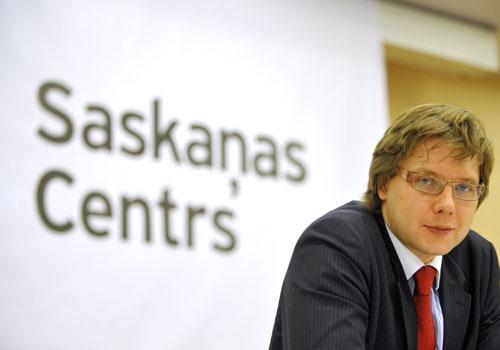
“Ethnic Voting” In Latvia: Three Misconceptions
Publication: Eurasia Daily Monitor Volume: 8 Issue: 197
By:

Latvia’s recent parliamentary elections, and the complicated process of forming a coalition government, sparked the most intensive debate yet on “ethnic voting” in Latvia. In many ways the country is bi-communal de facto, owing to Soviet-era immigration from Russia and Russification of non-Russian groups in Latvia. In this situation, Latvia’s politics generally and voter behavior in particular are perceived as polarized along ethnic lines.
The left-leaning Russian party, Harmony Center, suggested that its entry into Latvia’s governing coalition could help bridge the gap. Following the September 17 parliamentary elections, this idea gained some traction for the first time among some influential Latvian politicians and pundits. In this view, divisive voting along “ethnic lines” can be overcome through power-sharing with Harmony Center in Latvia’s government (see “A Latvian Government for Latvia,” EDM, October 26).
That oversimplified notion rests on several misperceptions:
1. The Latvian electorate and Latvian parties manifest ideological diversity and political pluralism across a center-to-right spectrum, dividing the vote accordingly. Ethnically-based Latvian parties are a reality but they pursue the full range of interests and concerns. This contrasts with the left-leaning, “ethnic”-interest Harmony’s monolith. In that sense, bloc voting and voting on primarily “ethnic” criteria is a Russian phenomenon in Latvia. This is hardly surprising, since Harmony’s raison d’etre is to represent the Russian/Russian-speaking population, being an “ethnic” party by definition in this respect.
2. Harmony incorporates non-Russian ethnic groups, Russified during the Soviet era and re-designated as the “Russian-speaking population,” thus erasing their original ethnic identity. Moscow continues encouraging this process so as to build a broader political front vis-à-vis Latvians. In that sense Harmony is not merely “ethnic,” but also an “internationalist” imperial leftover, stranded outside Russia, but still connected with the former imperial center through media support, political advice, diplomatic backing, and inter-party cooperation agreements.
3. Harmony maintains close political and business relations with certain Latvian oligarchs. In this particular respect, Harmony quite comfortably “overcomes the ethnic divide” (“bridges the gap”) already through its own devices. Harmony and Latvian oligarch Ainars Slesers’ party, forming a majority in the Riga City Council together, established a coalition model potentially applicable at the parliamentary level. An alliance of Russian voting-bloc power with Latvian oligarchic power again illustrates Harmony’s complexity. It is “ethnic” and much else besides.
An alliance of Harmony and Latvian oligarchic parties was forming in parliament in spring-summer 2011. To avert that danger, then-president Valdis Zatlers with the support of Unity and the National Alliance, called the recently held parliamentary elections (BNS, LETA, September 17-October 25).
President Berzins (Latvijas Avize, October 21) and his predecessor until August, now party leader Zatlers, along with several Latvian academic and journalistic pundits, urged inviting Harmony into a new coalition government. Within the Unity Party, only one of its three components considered this idea, until voter feedback quashed it. The National Alliance had ruled it out from the outset. When Unity as a whole refused to join a Zatlers Party-Harmony coalition, Zatlers finally reverted to the fold of the Latvian tripartite coalition. The argument that won the day (unlike the pro-Harmony argument) was not “ethnic,” but political. It focused on the substantive ideological and programmatic differences between Harmony and the three Latvian parties. A government with Harmony’s participation would have been divided and dysfunctional.
Apart from Harmony itself, Zatlers’s Party became unexpectedly the main advocate for inviting Harmony into the government after the September 17 elections. Almost certainly reflecting a shift in Zatlers’ view of the national interest at that point, he also had a narrower political interest at stake. Having lost his re-election bid as head of state in parliament in July despite his high popularity, Zatlers concluded that Latvia would be better served by popularly elected presidents. He needed, and sought, Harmony’s support for amending the constitution accordingly. At the last moment he pulled out of such a deal (Latvia in Review, October 17-24).
The case for a government with Harmony’s participation rested on the idea that Latvia should overcome “ethnically-based” politics. The proposed remedy, however, attempted to cure a symptom (Harmony being permanently in the opposition), instead of addressing the causes behind it (Harmony’s leftist ideology, oligarch connections, Russian orientation, and problematic attitudes toward the Latvian state and the West).
The attempt to overcome “ethnic” politics by bringing Harmony into government was illusory on three levels. First, it would have actually institutionalized ethnic politics by empowering a party of “ethnic” interest representation in the government. Second, it would not have resolved the other problems that disqualify Harmony from joining the government (see above). And third, power-sharing with a political force of Harmony’s size and aggressiveness could have destabilized Latvia’s government.




